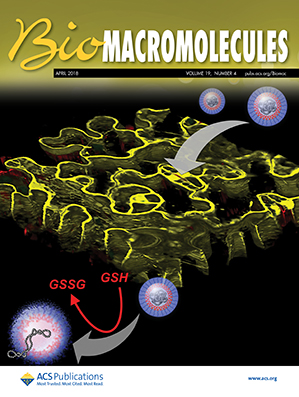Multifunctional Macrofibers via Wet Spinning: Integrating Antibacterial, Flame-Retardant, and UV Shielding Properties Using Multinetwork Cellulose-Based Aqueous Colloids
IF 5.4
2区 化学
Q1 BIOCHEMISTRY & MOLECULAR BIOLOGY
引用次数: 0
Abstract
Wet spinning of nanocellulose in purely aqueous systems for functionalized filament formation represents a significant yet challenging research frontier. This study develops a sustainable wet-spinning approach to produce high-performance macrofibers using TEMPO-oxidized bacterial cellulose nanofibers (TOBCN), sodium alginate (Alg), and metal-phenolic networks (MPNs). The system utilizes Fe3+-mediated cross-linking in MPNs combined with Ca2+-induced ionic bonding with TOBCN to achieve enhanced mechanical properties. The optimized Alg/TAFe1-TOBC2 fiber demonstrates remarkable multifunctional characteristics, including photothermal antibacterial efficacy exceeding 99% against both Escherichia coli and Staphylococcus aureus, superior flame retardancy with 61.05% lower heat release compared to cotton, and excellent UV protection with UV protection factor values surpassing 100, which exceed standard textile requirements. The purely aqueous processing and biomass-based composition ensure environmental compatibility and biocompatibility. These macrofibers hold promise for protective textiles, combining sustainability with high performance.
- Download: Download high-res image (149KB)
- Download: Download full-size image
湿纺多功能大纤维:利用多网络纤维素基水性胶体整合抗菌、阻燃和紫外线屏蔽性能。
在纯水体系中湿纺纳米纤维素用于功能化长丝的形成是一个重要但具有挑战性的研究前沿。本研究开发了一种可持续的湿纺丝方法,利用tempo氧化细菌纤维素纳米纤维(tobn)、海藻酸钠(Alg)和金属酚网络(mpn)生产高性能大纤维。该系统利用Fe3+介导的mpn交联,结合Ca2+诱导的与tocn的离子键来实现增强的机械性能。优化后的Alg/ tafe1 - toc2纤维具有显著的多功能特性,对大肠杆菌和金黄色葡萄球菌的光热抑菌效果均超过99%,阻燃性能优越,放热比棉低61.05%,防紫外线性能优异,紫外线防护系数超过100,超过纺织品标准要求。纯水处理和生物质成分确保了环境相容性和生物相容性。这些大纤维有望成为保护性纺织品,将可持续性与高性能相结合。
本文章由计算机程序翻译,如有差异,请以英文原文为准。
求助全文
约1分钟内获得全文
求助全文
来源期刊

Biomacromolecules
化学-高分子科学
CiteScore
10.60
自引率
4.80%
发文量
417
审稿时长
1.6 months
期刊介绍:
Biomacromolecules is a leading forum for the dissemination of cutting-edge research at the interface of polymer science and biology. Submissions to Biomacromolecules should contain strong elements of innovation in terms of macromolecular design, synthesis and characterization, or in the application of polymer materials to biology and medicine.
Topics covered by Biomacromolecules include, but are not exclusively limited to: sustainable polymers, polymers based on natural and renewable resources, degradable polymers, polymer conjugates, polymeric drugs, polymers in biocatalysis, biomacromolecular assembly, biomimetic polymers, polymer-biomineral hybrids, biomimetic-polymer processing, polymer recycling, bioactive polymer surfaces, original polymer design for biomedical applications such as immunotherapy, drug delivery, gene delivery, antimicrobial applications, diagnostic imaging and biosensing, polymers in tissue engineering and regenerative medicine, polymeric scaffolds and hydrogels for cell culture and delivery.
 求助内容:
求助内容: 应助结果提醒方式:
应助结果提醒方式:


